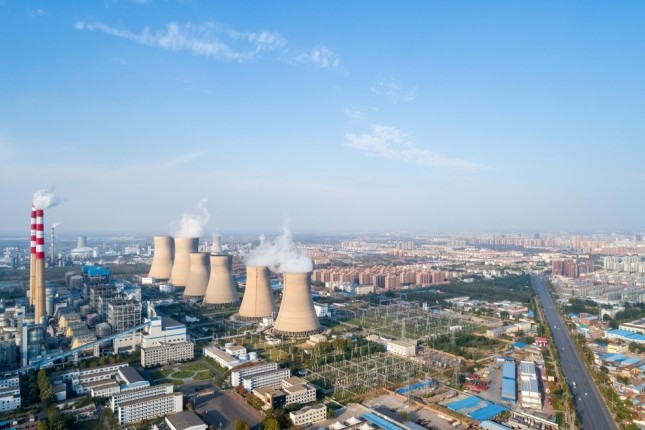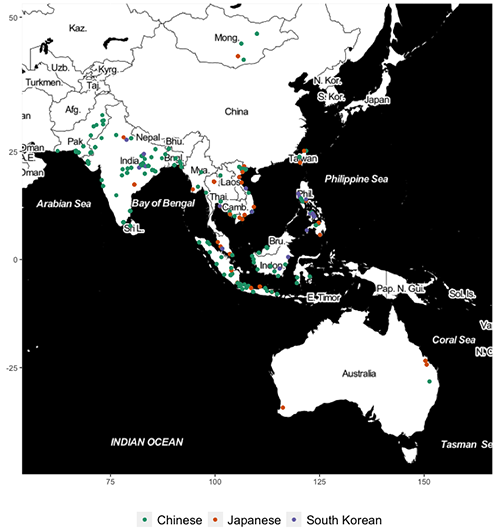-
China, Japan, and Korea: “Cleaner” Than the Worst Coal Plants, but Nowhere Near “Clean” Energy

The convergence of environmental pressures and economic recession due to the COVID-19 pandemic makes the future of international finance for coal-fired power plants increasingly uncertain. Environmental advocates have long been concerned about international coal investments locking host nations into decades of harmful air pollution and carbon dioxide emissions that cause global climate change. Now, the future of these planned coal plants is at a crossroads.
To understand what may happen in the future, we take a look at China, Japan, and South Korea, the largest enablers of new coal projects around the world. We compare the past ventures of Chinese, Japanese, and Korean companies to understand how their changing stances on coal may affect the future of CO2 emissions. Japan and Korea are making policy moves to shift away from coal. However, even while setting more stringent targets domestically, China is continuing to enable unsustainable coal overseas.
Coal in Asia
Coal remains a dominant source of power generation in Asia due to its price and availability. Japan, the top public financier of coal power projects since 1994, has long been criticized by domestic and international environmental groups for backing fossil fuels abroad. Korea has been similarly criticized for backing coal plants that do not adhere to its domestic environmental standards. Now, China faces similar scrutiny.
Japanese developers have rationalized their investments by insisting that they are purveyors of the “cleanest” coal technology and, as such, can provide poor countries with cleaner coal. Japan’s 5th Strategic Energy Plan even stated that Japan should only supply coal technology “at or above ultrasupercritical pressure (USC), the global state-of-the-art.”
Prior research has demonstrated that coal plants in Asia owned, designed, and built by Chinese companies tend to be cleaner in terms of CO2 emissions intensity and energy efficiency than plants of non-Chinese companies. But what about the overseas coal plants of Japanese and Korean companies? Who, really, is developing the “cleanest” coal?
Finding the “cleanest” coal
To characterize the involvement of Chinese, Japanese, and Korean actors in a given overseas coal project, we look at the types of companies involved in that coal plant. We examine three types of companies: parent companies, architecture and engineering companies, and construction companies. While parent companies represent foreign direct investment (FDI), engineering and construction companies typically represent engineering, procurement, and construction (EPC) arrangements, which play an important role in the technology choices for a plant and may also operate it.
Using this definition, we map out the coal plants with involvement from Chinese, Japanese, and Korean companies in the rest of Asia.
We find 483 coal plants with Chinese company involvement, 110 plants with Japanese company involvement, and 58 plants with South Korean company involvement. We also find that Chinese and Korean involvement tends to be overwhelmingly through engineering and construction companies (i.e. EPC contracts), while Japanese plants have a higher proportion of involvement via parent companies, representing FDI.
So whose plants are the “cleanest”? We used CO2 emissions intensity as our comparison metric. This refers to the amount of CO2 emitted per unit of energy produced, and is a measure of efficiency rather than absolute emissions, which allows comparison of plants of all different sizes.
Looking at the average emissions intensity of each country’s overseas fleet in this region, we find that Japanese and Chinese plants are roughly equal, at 1.14 tCO2/MWh. However, Korean plants have much lower emissions intensity, at 0.97 tCO2/MWh. The average emissions intensity of all coal plants in Asia is 1.21 tCO2/MWh.
COUNTRY OF COAL PLANT DEVELOPER NUMBER OF PLANTS IN ASIA AVERAGE SIZE (MW) AVERAGE AGE (YEAR BUILT) PERCENT SUBCRITICAL, SUPERCRITICAL, AND USC China 483 311 2012 78.7%, 18.6%, 2.7% Japan 110 433 2003 73.8%, 10.7%, 15.5% Korea 58 404 2015 59.2%, 27.8%, 13.0% Going by this rough estimate, we can see that all three countries may have cause to claim that their coal plant technology is relatively advanced, and Korea especially so.
Analyzing market giants
What could explain this finding? To learn more, we investigated the companies that are involved in these overseas plants.
Many of China’s largest state-owned energy companies are involved as parent companies overseas coal plants. Chinese EPC contractors, on the other hand, tend to be vertically integrated private companies that provide logistics, equipment, and design services. While they have fewer years of overseas experience compared to Japanese companies, the sheer scale of China’s domestic coal power sector means that these companies are highly specialized, and China has the world’s largest fleet of highly efficient ultra-supercritical (USC) plants.
The top Japanese companies involved in overseas coal plants – Sumitomo, Marubeni, Mitsubishi, and Mitsui – are all sōgō shōsha, large general trading companies. Many of these behemoths have been involved in overseas coal holdings since the 1960s. Despite Japan’s overseas coal plants being older on average, their emissions intensities are approximately on par with those of Chinese companies, indicating they have indeed focused on efficient technologies.
The top Korean companies involved in overseas coal plants consist of Korea’s largest electric utility, KEPCO, several chaebols, and POSCO, Korea’s largest steel company. These companies became involved in overseas coal later than Japan. An overall newer fleet could account for their comparatively lower average emissions intensity.
Shifting trends due to policy and perception
While China has yet to announce any formal restrictions on overseas coal power, recently, Japan and Korea have made moves in that direction. Japanese megabanks Mitsubishi UFJ, Sumitomo Mitsui, and Mizuho have announced they will stop financing new coal projects. Meanwhile, South Korea’s Green New Deal includes provisions for the phaseout of both domestic and overseas coal financing.
While China, Japan, and Korea may vie for the title of “cleanest” to justify involvement in overseas coal power generation, it is important to remember that even the most advanced coal plants are still far worse for the climate and public health than cleaner sources of electricity, especially renewable energy. The average emissions intensity for coal is much higher than for other fuels – for example, 0.461 tCO2/MWh for natural gas in the United States, and close to zero for low-carbon sources like wind and solar.
China’s recently announced goal of carbon neutrality by 2060 has created an even larger gap between its domestic climate policy and the reality of its overseas investment portfolio. In the wake of this announcement, there is a clear opportunity for Chinese leaders to formulate policies to encourage cleaner energy investments overseas. As it stands, coal-fired power plants are the dominant destination for Chinese overseas investment in electricity generation.
Not long after China announced its 2060 carbon neutrality target, Japan and South Korea released their own carbon neutrality targets for 2050 – a “race to the top” for demonstration of climate leadership. However, China is lagging behind Japan and South Korea in managing overseas coal. There is a danger that China could fill the gap left by the dearth of Japanese and Korean capital for overseas coal. For comprehensive climate leadership, China should also formulate stringent and binding policies to encourage overseas investment in clean energy.
The authors would like to thank Jessica Liao, Han Chen, Jennifer Turner, and Lucas Myers for their helpful comments on earlier versions of this piece.
Cecilia Han Springer is a China Fellow with the Wilson Center’s Asia Program and Kissinger Institute on China and the United States and Senior Researcher at Boston University’s Global China Initiative. Cecilia uses interdisciplinary methods for her research, combining economic modeling and qualitative fieldwork to study climate and energy policies in China and around the world. Her research focuses on the environmental impacts of the Belt and Road Initiative.
Sources: Boston University Global Development Policy Center, Cecilia Springer et al. (2020), Energy Policy, Greenpeace, The Center for International Environment & Resource Policy, The Government of Japan, The International Energy Agency, The Japan Times, and The New York Times.
Photo Credit: A thermal power plant in Dezhou City, Shandong Province, China, courtesy of chuyuss/Shutterstock.com
 A Publication of the Stimson Center.
A Publication of the Stimson Center.




